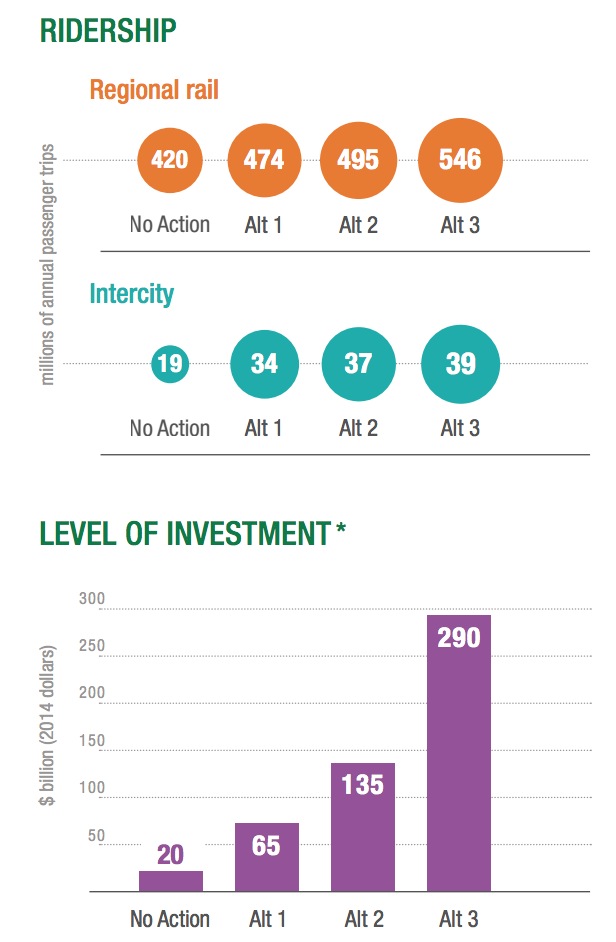NEC FUTURE
Choices for the NEC
The FRA has identified three distinct Action Alternatives for the NEC, each of which presents a different vision for the future role of passenger rail in the transportation system of the Northeast. In developing these Action Alternatives, the FRA considered a broad range of possibilities for the NEC to respond to future travel market trends, passenger service needs, and public input. The Tier 1 Draft EIS compares each Action Alternative to a baseline, the No Action Alternative.
- Alternative 1 MAINTAINS the role of rail with sufficient additional service to keep pace with population and employment growth.
- Alternative 2 GROWS the role of rail with service to new markets and accommodates a greater portion of the population.
- Alternative 3 TRANSFORMS the role of rail by becoming a dominant mode choice for travel in the Northeast.
…
Evaluating the Alternatives
The Tier 1 Draft EIS presents a detailed evaluation of the No Action and Action Alternatives for NEC FUTURE, including their effects on transportation, the economy, the built and natural environment, as well as projected ridership, capital and operating costs, construction requirements, and phasing.
The range of benefits and effects varies by Action Alternative, based on the service and infrastructure proposed. Examples of the findings are shown on this page.
 Effects on the Built and Natural Environment
Effects on the Built and Natural Environment
Alternative 1: Environmental impacts occur with the addition of two segments in Connecticut and Rhode Island outside of the existing NEC right-of-way, including impacts on land cover, water resources, ecological resources, prime farmlands, and prime timberlands.
Alternative 2: Environmental impacts primarily occur with the addition of a new segment between New Haven and Providence, via Hartford. Much of this area is less developed and key considerations are the effects of acquisitions and displacements in noted environmental justice communities, and impacts on prime timberlands and floodplains.
Alternative 3: Impacts to the built and natural environment occur along the entire length of the additional spine between Washington, D.C., and Boston, MA. A range of effects occur north of New York City, due to variations in routing; impacts include conversion of undeveloped land, acquisition of developed land, impacts on water and ecological resources, and conversion of prime farmland and timberlands.
More-detailed environmental reviews at the Tier 2 (project) level will be needed to identify specific community and resource impacts and benefits, seek public and agency input, and identify mitigation measures, if necessary.
What’s at stake in this decision?
The selection of an investment program for the NEC will have far-reaching effects on transportation in the Northeast. It will help to define how and when the federal government, states, and railroads invest in upgrades to the NEC, with implications for the mix of rail services offered, service frequency, travel times, and stations served. The construction of new infrastructure and the operation of expanded services would create jobs and economic development opportunities, as well as result in impacts to properties and effects on the natural environment. The FRA has analyzed the No Action and Action Alternatives at a Tier 1 (broad) level of detail in order to understand and compare these effects. The analysis is presented in the Tier 1 Draft EIS.
What Happens Next?
After considering the analysis presented in the Tier 1 Draft EIS and comments received from the public, agencies, and railroad stakeholders, the FRA will identify a preferred investment program (Preferred Alternative) that provides a framework for future rail improvements on the NEC. The Tier 1 Final EIS will describe and evaluate this Preferred Alternative. The FRA will formally select an alternative (Selected Alternative) in a Record of Decision to complete the Tier 1 environmental review process, and develop a Service Development Plan that defines the process for implementing the Selected Alternative.
The Selected Alternative will be a road map for incremental improvement of the NEC necessary to achieve the selected vision for passenger rail in the NEC. A phasing plan will describe the priorities and proposed approach to implementing the improvements so that benefits throughout the NEC are maximized. As a framework for future rail improvements on the NEC, the Selected Alternative does not require any rail operator to fund or construct new infrastructure, but ensures that future investments by any entity are consistent with the long-term NEC vision and benefits all of its users. Improvements will be carried out as discrete projects that will undergo more detailed planning and environmental analysis.
View full report (necfuture.com): Our Future on Track
About NEC Future
www.necfuture.com
NEC FUTURE is a comprehensive planning effort to define, evaluate, and prioritize future investments in the Northeast Corridor (NEC), from Washington, D.C. to Boston. The Federal Railroad Administration (FRA) launched NEC FUTURE in February 2012 to consider the role of rail passenger service in the context of current and future transportation demands. Through the NEC FUTURE program, the FRA will determine a long-term vision and investment program for the NEC, and provide a Tier 1 Environmental Impact Statement (EIS) and Service Development Plan (SDP) in 2016 in support of that vision.
Tags: Federal Rail Administration, FRA, NEC, NEC Future, Northeast Corridor






 RSS Feed
RSS Feed